In my garden, I have a big rosemary bush that I use every year. I’ve learned how to harvest it without harming the plant. Rosemary can be harvested all year, but the best time is in the summer, just before or during flowering. This is when the plant’s oils are strongest. Avoid taking from it in the winter when it’s dormant.
When you harvest, only take up to 3/4 of the plant. Leave at least 1/4 with leaves for the plant to grow back. Proper pruning and watering after harvesting will help it recover and keep it healthy.
Introduction
Rosemary (Rosmarinus officinalis) is a versatile and aromatic herb. It’s been a staple in many kitchens for a long time. This evergreen shrub adds unique flavor to dishes and has many rosemary plant benefits.
It’s full of antioxidants and may help reduce inflammation. Adding rosemary to your garden is a smart move. But, to keep enjoying this tasty herb, learning about rosemary plant care and harvesting techniques is key.
Preserving Rosemary’s Potency
How you pick rosemary affects its flavor and potency. Using fresh rosemary is best because it keeps the most beneficial compounds. These include rosmarinic acid and carnosic acid, which fight off inflammation and act as antioxidants. If you pick it wrong, you lose these good stuff, making the rosemary culinary uses less effective.
Also, keeping rosemary fresh after picking is important. You can air-dry or freeze it to keep it good for longer. This way, you can enjoy its special taste and smell all year.
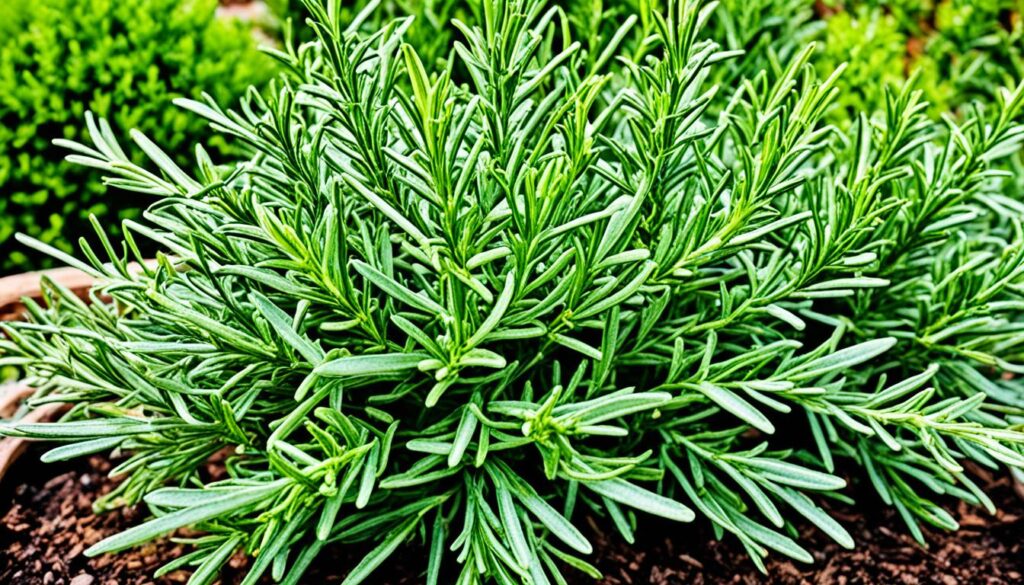
“Proper harvesting and preservation techniques are the keys to ensuring you can continue to enjoy the exceptional flavor and benefits of your homegrown rosemary for years to come.”
The Best Time to Harvest Rosemary
Timing is key when it comes to harvesting rosemary. This herb grows best in spring and summer. These are the best times to pick its leaves and stems. Harvesting just before or during the plant’s bloom gets you the most aromatic oils and flavor.
Don’t harvest rosemary in winter when it’s dormant. This can harm its health and growth. Harvesting in the morning, after the dew dries, is best to keep the herb’s oils intact.
You can start harvesting rosemary when it grows new tips and branches. Cutting off tender new tips or stems that are at least 8 inches long is a good way to harvest. The leaves are full of flavor and oils, great for cooking and teas.
| Rosemary Harvesting Seasons | Optimal Harvesting Time |
|---|---|
| Spring and Summer | Before or during flowering period |
| Winter | Avoid harvesting, as plant is dormant |
| Morning (after dew has dried) | Best time to preserve essential oils |
Knowing about rosemary plant growth cycles and when to harvest rosemary helps gardeners get a great harvest all season.
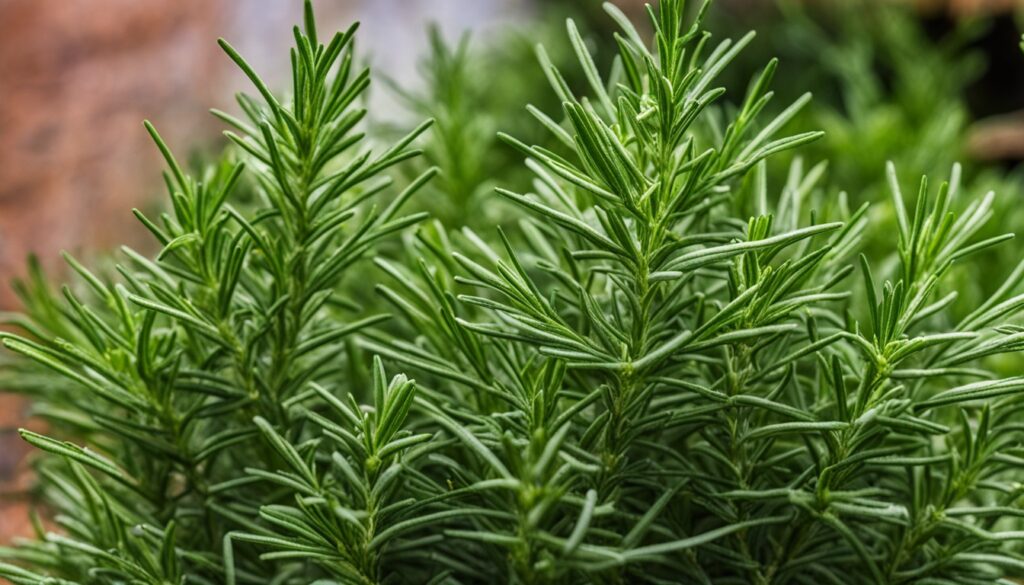
Selecting the Right Branches
When harvesting rosemary, picking the right branches is key. Look for stems that are at least 8 inches long. The tender new growth is great for fresh use, and the woody stems are good for cooking too. But, don’t take cuttings from new growth as it can harm the plant.
To take rosemary without hurting the plant, use sharp scissors or pruners. Make sure to leave at least 1/4 of the plant’s foliage. This helps the plant grow back after you take some.
Choosing the Ideal Sprigs
When picking rosemary sprigs, choose those that are firm, smell good, and look healthy. The leaves should be bright green, and the stems should be flexible but not too hard.
- Aim for rosemary stems that are at least 8 inches long.
- Avoid cutting from newly emerging branches, as this can stress the plant.
- Use sharp, sterile scissors or pruners to take cuttings, leaving 1/4 of the plant’s foliage intact.
- Choose sprigs with firm, fragrant leaves and flexible, healthy stems.
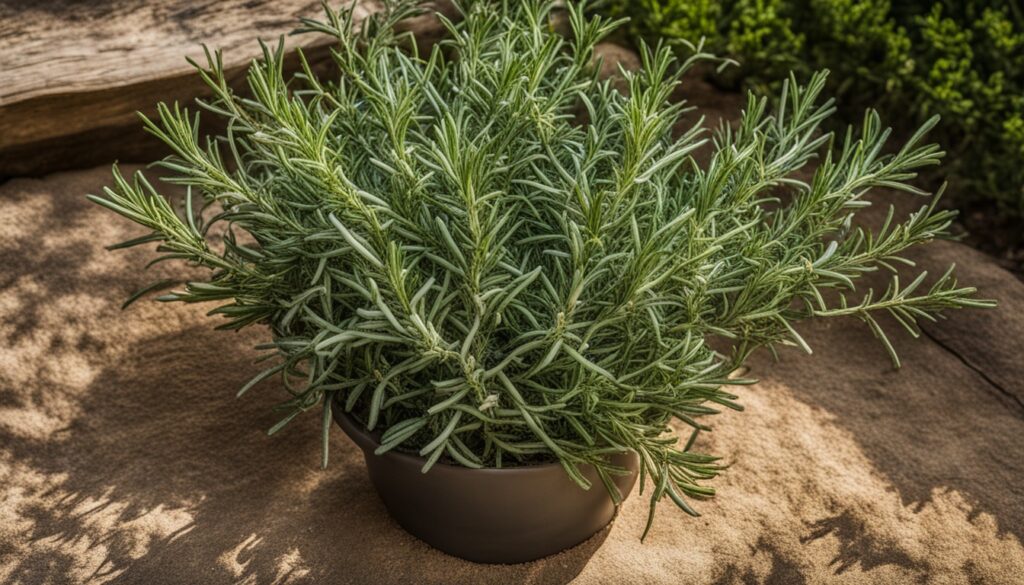
By picking the right rosemary branches and sprigs, you can enjoy fresh, tasty herb. And, you’ll help your rosemary plant stay healthy and grow well.
How to Harvest Rosemary Without Killing The Plant
Harvesting rosemary needs a careful touch to keep your plant healthy and productive. Here are some tips for a sustainable harvest without harming your plant.
- Time it Right: Don’t take rosemary during the winter when it sleeps. The best times for step-by-step rosemary harvesting are in the spring and summer when it grows.
- Select the Right Branches: Pick stems that are at least 20 cm long. Make sure to leave at least 1/4 of the plant’s leaves.
- Cut the Stems: Use sharp scissors or pruners to cut the stems. Take up to 3/4 of the plant’s growth.
- Water and Fertilize: After cutting, water the plant well and give it a balanced fertilizer to help it recover and grow strong.
- Monitor for Changes: Watch the plant closely for any strange signs or problems after the rosemary pruning techniques.
Trim your rosemary every two weeks to make it bushier and increase your harvest. By following these steps, you’ll get a lot of rosemary while keeping your plant healthy.
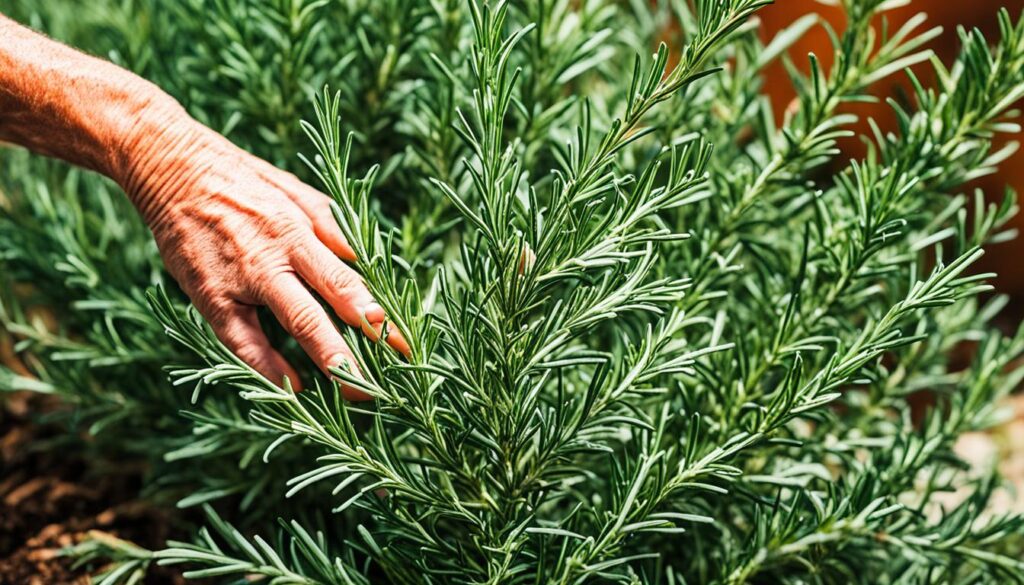
“Proper step-by-step rosemary harvesting is key to maintaining a healthy, productive rosemary plant that will continue to provide you with its aromatic and flavorful leaves for years to come.”
Storing Fresh Rosemary
Keeping fresh rosemary’s flavor and scent is key to enjoying this versatile herb. There are several ways to store rosemary and keep it fresh. One method is to put the stems in water, like a flower bouquet, and cover with a plastic bag in the fridge. This can make rosemary last up to two weeks.
You can also wrap rosemary stems in paper towels and put them in a plastic bag in the fridge. This keeps the herb fresh for 3-5 days. For longer storage, you can dry rosemary by hanging it upside down in a dark, airy spot. Dried leaves can be kept in airtight containers for up to a year.
Preserving Your Harvest
Freezing is another great way to keep rosemary fresh. You can freeze whole sprigs or chop the leaves and freeze them in water or oil. Freezing rosemary helps it keep its softness better than drying. Choose between freezing whole sprigs or chopped leaves in oil or water based on what you need.
To improve freezing, add a bit of cornstarch when chopping the rosemary. This makes the leaves powder and absorb some oils, making them easier to use when thawed. For the best storage, use double freezer bags or tightly sealed jars to keep your frozen rosemary fresh for up to a year.
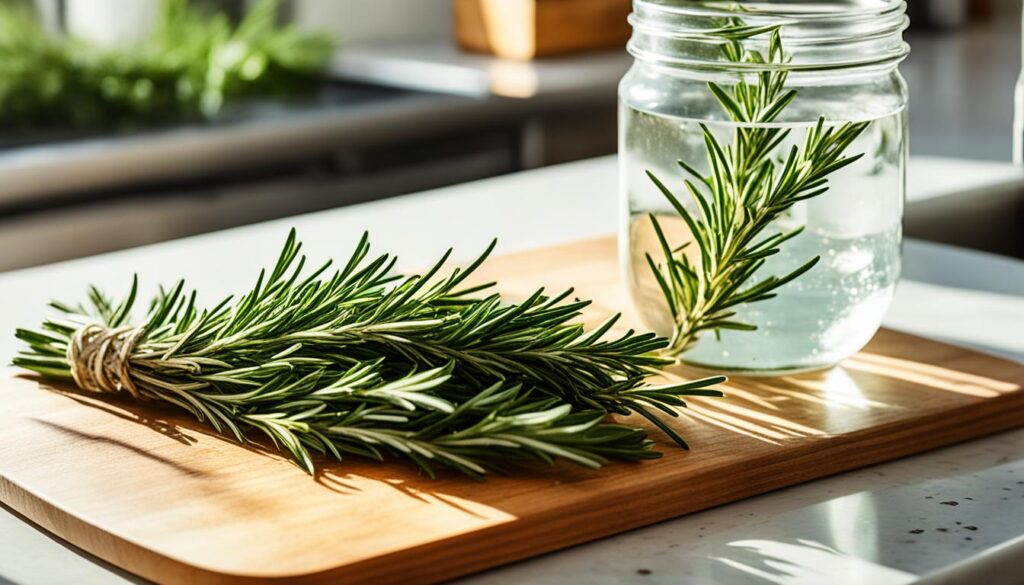
“Frozen rosemary is favored over dried rosemary due to its ability to retain the softness of the leaves, with frozen rosemary being described as closest to fresh.”
Drying Rosemary
Drying rosemary is a great way to keep its leaves fresh for a long time. You need to pick the rosemary at the best time and use the right drying methods. This helps keep the herb’s flavor and smell.
The best time to pick rosemary for drying is right before it starts to bloom. The leaves have the most oils then. Tie the stems together in small bunches and hang them upside down in a dark place with good air flow. It usually takes about 10 days to dry completely.
After drying, take the leaves off the stems and put them in airtight containers. Dried rosemary can keep its taste and smell for up to a year. Don’t use a dehydrator because the high heat can ruin the essential oils that make rosemary special.
| Rosemary Drying Methods | Pros | Cons |
|---|---|---|
| Air Drying | Preserves essential oils, easy, low-cost | Longer drying time, susceptible to dust/debris |
| Oven Drying | Faster drying, better control | Can damage essential oils, risk of overcooking |
| Microwave Drying | Very fast, compact method | High risk of scorching, uneven drying |
By using these how to dry rosemary methods, you can keep preserving dried rosemary. This way, you can enjoy its great flavor and smell even after the growing season is over.
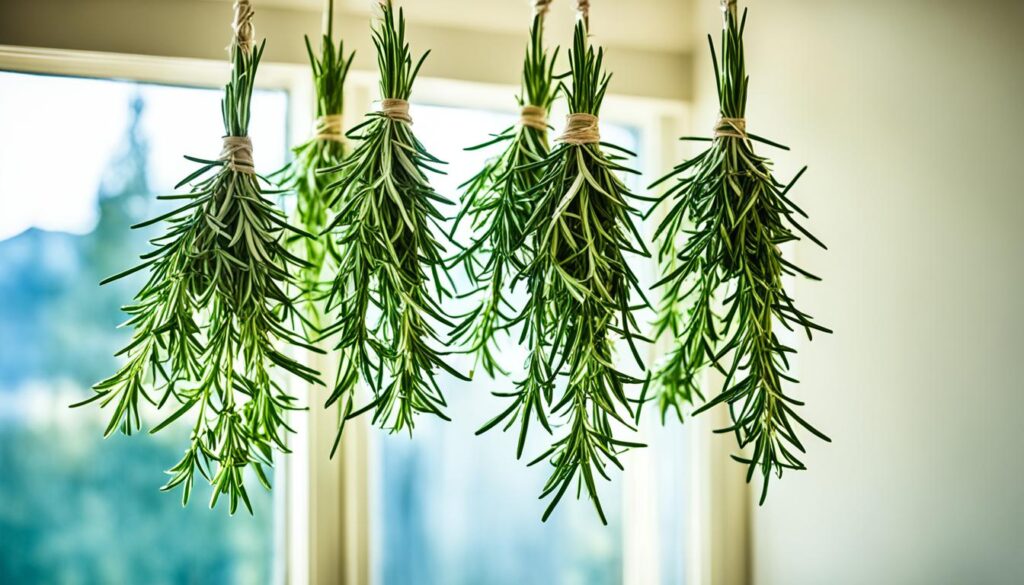
Maintaining Your Rosemary Plant
Keeping your rosemary plant healthy and thriving takes regular care. Even if you’re not using the leaves, pruning it several times a year helps. This keeps the plant bushy and vibrant.
Pruning for Healthy Growth
When you prune your rosemary, make sure to keep at least 1/4 of its leaves. Prune often but lightly, rather than cutting a lot at once. This helps the plant recover fast and stay healthy.
- Prune rosemary several times a year to keep its shape and promote bushy growth.
- Avoid cutting off more than 1/3 of the plant’s leaves at once to prevent stress.
- Do the last harvest 2 weeks before the first frost to let the plant regrow before winter.
Regular watering and a balanced fertilizer in early spring also help your rosemary. With the right care, your rosemary can thrive for many years.
“Rosemary responds well to pruning and can be trained into topiary shapes without pruning off more than a third of the plant at a time.”
Conclusion
Harvesting rosemary from my garden has been rewarding and fun. I learned how to time the harvest, prune the plant, and store the leaves right. This way, I can use the leaves in my cooking and even for health and personal care.
Rosemary is tough and can give lots of harvests for years with the right care. I keep an eye on its growth, prune it, and preserve the leaves. This lets me enjoy my rosemary plant for many seasons. I’m excited to keep using this amazing herb in my cooking and wellness routines.
If you’re new to gardening or already love rosemary, harvest it with care for the plant’s health. This ensures a steady supply of this great herb. Enjoy your harvesting journey!
FAQ
When is the best time to harvest rosemary?
Harvest rosemary in the summer, just before or during its flowering. This is when the aromatic oils are most potent. Avoid harvesting in winter when the plant is dormant.
How much of the rosemary plant should I harvest at a time?
Take no more than 3/4 of the plant when harvesting. Leave at least 1/4 of the branches and leaves intact. This lets the plant regrow.
What is the proper way to harvest rosemary without damaging the plant?
Harvest rosemary without harm by following these steps: 1) Choose the right time, 2) Select branches at least 20 cm long, 3) Cut the stems, taking up to 3/4 of the plant, 4) Leave at least 1/4 of the branches and leaves intact, 5) Water the plant thoroughly after harvesting, and 6) Apply a balanced fertilizer to help the plant recover.
How can I store fresh-harvested rosemary to extend its shelf life?
Store fresh-harvested rosemary by placing stems in a glass of water and covering with a plastic bag in the fridge. Or, wrap stems in paper towels and store in a plastic bag. You can also dry the herb by hanging bundles upside down in a dark, well-ventilated area.
How should I dry rosemary for long-term storage?
Harvest rosemary just before it blooms for drying. Tie stems into small bundles and hang them upside down in a dark, well-ventilated area for about 10 days until dry. Then, store the dried leaves in airtight containers.
How can I maintain a healthy, productive rosemary plant?
Keep your rosemary plant healthy by pruning it several times a year. This encourages bushy, healthy growth. Leave at least 1/4 of the foliage intact. Water the plant regularly, especially during dry spells, and apply a balanced fertilizer in early spring.
